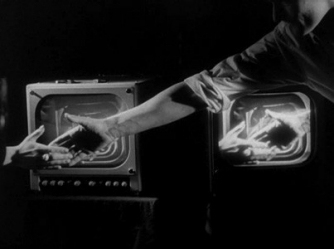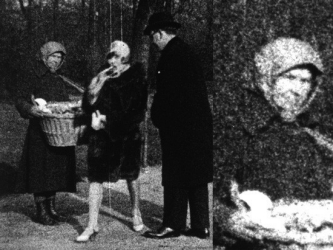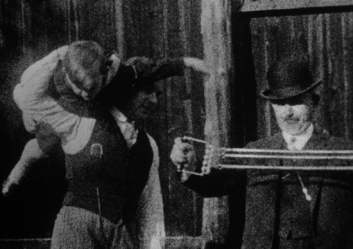Banner stills L to R: Long Distance Runner, Four Bagatelles, and New Year's Eve, all courtesy MaNDA Archive
Four Bagatelles and Private History
Four Bagatelles (Film Language Series) (Négy Bagatell)
Gábor Bódy, Hungary, 1975, 35 mm transfer to digiBeta, 27 minutes 40 seconds
Four Bagatelles was produced as part of the BBS’s Film Language Series, founded in 1972, which established the most radical modes of experimental filmmaking at the studio. The series proposed to analyze the linguistic structures of film while simultaneously examining the functioning and meaning of the filmic image through both theoretical writings and practice. In addition, it opened up opportunities for filmmakers, through an open call organized in 1973, which resulted in the initial production of ten experimental works, Four Bagatelles among them.[1]

Still from Four Bagatelles, courtesy MaNDA Archive
Gábor Bódy’s (1946–1985) formal investigations were aligned with a “linguistic turn” of film studies in the 1960s and 1970s, which produced theoretical explorations of the connections between film and language, most notably through the work of French theoretician Christian Metz.[2] This development widely followed a broad interest in the field of structuralism across different disciplines in the humanities and social sciences, which built on linguistics to investigate universal structures and systems within a given text or body of work.
Bódy and fellow filmmakers and artists, including Miklós Erdély and Dóra Maurer, participated in this new strand of nonnarrative cinematic experimentation in forceful opposition to the conventional narrative structures of traditional modes of documentary and fiction film production that prevailed in Hungary and the BBS at the time. In doing so, they ambitiously sought to integrate moving images more clearly into the different modes of avant-garde experimentation within the arts, away from the realm of narrative and commercial filmmaking.[3]
Four Bagatelles is a key work in Gábor Bódy’s oeuvre that illustrates his central artistic concerns. The study of the filmic image is achieved here through a series of formal interventions added onto preexisting footage culled from a wide range of sources. As the studio’s catalog explains, “of the essentially infinite number of bagatelles” (in classical music, bagatelles are short pieces of music often written in sets), the film selects four: archival footage of two folk dancers, a sequence showing a modern dancer’s abstract movements, reworkings of sections of his film Tradicionális kábítószerünk (Our Traditional Drug) from 1973, and a final image showing the infinite effect of two mirrors turned facing each other.[4] These sequences are variously transformed by a perpetually moving crosshair dissecting the frame, an intentionally misaligned film strip fragmenting the human bodies displayed on-screen, and an ever-shifting iris effect that focuses attention on a circular segment of an otherwise black screen. These gestures foreground the materiality of film and invite viewers to repeatedly refocus their attention to different elements of the image. They ask viewers to reassess their approach to cinema and unearth novel meanings within the four disparate pieces included in the film. Through these reflections on form and content, Bódy ultimately highlights the omnipresence of the artist guiding the viewer’s gaze. — Sonja Simonyi
With thanks to Sebestyén Kodolányi at the Balázs Béla Stúdió Archive and Dorottya Szörényi at the Hungarian National Digital Archive and Film Institute (Magyar Nemzeti Digitális Archívum és Filmintézet [MaNDA]) for their assistance with research and help in making the screening of this film possible in Washington.
Private History (Privát Történelem)
Gábor Bódy and Péter Tímár, Hungary, 1978, 35 mm transfer to digiBeta, 25 minutes

Still from Private History, courtesy MaNDA Archive
Deconstructing historical metanarratives through found home movie footage is a cinematic genre that in recent decades has become the trademark of the Hungarian media artist Péter Forgács. His ongoing Private Hungary (Privát magyarország) series first began in 1988, with a number of early episodes produced at the BBS. Gábor Bódy’s (1946–1985) and Péter Tímár’s (b. 1950) Private History is an important precursor and a clear influence on Forgács’ style as a film that excavated moving images from the decades preceding World War II in order to construct a complex visual narrative of Hungary’s tumultuous interwar period. The close connection between Forgács’ work and Bódy’s film is illustrated by the fact that Private History and the initial episode of Private Hungary, entitled The Bartos Family (1988), both culled footage from the collections of the amateur filmmaker Zoltán Bartos.

Still from Private History, courtesy MaNDA Archive
Bódy conceived of this project as early as 1975, working with Tímár, who contributed the special effects to his ambitious feature film American Postcard (Amerikai anzix, 1975) and whom Bódy introduced to the studio. Private History was ultimately produced in 1978, not at the Balázs Béla Stúdió, but at the News and Documentary Studio (Híradó- és Dokumentumfilm Stúdió). As Bódy stated in a text he wrote to explain the key objectives of this project, the use of archival footage in the film is meant to produce a “visual chronicle” that highlights the “connections and disjunctions between private and public consciousness,” exploring the relations among subjective experience, individual fates, and broader historical trajectories.[5] In its ambition to reconcile private and public historical trauma through the manipulation of archival footage, the film exemplifies the innovative and wide-ranging formal and intellectual inquiry that drove cinematic experimentation at BBS. It enters into intellectual and formal dialogue with the work of two other filmmakers presented in the opening of the series: Dušan Makavejev’s uses of archival footage and Jonas Mekas’ exploration of the interlinked personal and communal trauma. It also reveals Bódy’s keen understanding of the importance of preserving and archiving audiovisual heritage through creative means. — Sonja Simonyi
With thanks to Sebestyén Kodolányi at the Balázs Béla Stúdió Archive and Dorottya Szörényi at the Hungarian National Digital Archive and Film Institute (Magyar Nemzeti Digitális Archívum és Filmintézet [MaNDA]) for their assistance with research and help in making the screening of this film possible in Washington.
1. “A filmnyelvi sorozat vitájához” [For the discussion of the Film Language School] (1974), reprinted in Bódy Gábor: egybegyűjtött filmművészeti írások [Bódy Gábor: Collected writings on film], ed. Vince Zalán (Budapest, 2006), 94–95. (back to top)
2. For example, see Bódy’s essay “Filmművészet, a film nyelve, filmi gondolkodás” [Film art: The language of film, filmic thought] (1972?), reprinted in Bódy Gábor: egybegyűjtött filmművészeti írások [Bódy Gábor: Collected writings on film], ed. Vince Zalán (Budapest, 2006), 58–65. (back to top)
3. Bódy Gábor, “A ‘kísérleti film’ Magyarországon” [The “experimental film” in Hungary] Filmvilág 3 (1982): 11–13. (back to top)
4. Izabella Füzi. “A fotografikus nyomtól a végtelen képig: a BBS filmelméleti kisérletei” [From the photographic trace to the endless image: The film theoretical experimentations of BBS], in BBS 50: A Balázs Béla Stúdio ötven éve [BBS 50: Fifty years of the Balázs Béla Studio] (Budapest, 2009), 260–61. (back to top)
5. “Privát történelem (I.) tématerv” [Private history, subject plan] (1975), reprinted in Bódy Gábor: egybegyűjtött filmművészeti írások [Bódy Gábor: Collected writings on film], ed. Vince Zalán (Budapest, 2006), 197. (back to top)



